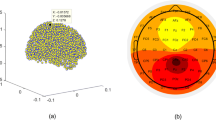Abstract
EEG time series were modeled as an output of the linear filter driven by white noise. Parameters describing the signal were determined in a way fulfilling the maximum entropy principle. Transfer function and the impulse response function were found. The solutions of the differential equations describing the system have the form of the damped oscillatory modes. The representation of the EEG time series as a superposition of the resonant modes with characteristic decay factors seems a valuable method of the analysis of the signal, since it offers high reduction of the data to the few parameters of a clear physiological meaning.
Similar content being viewed by others
References
Akaike H (1974) A new look at statistical model identification. IEEE Trans AC-19:716–723
Akaike H (1965) On the statistical estimation of frequency response function. Ann Inst Stat Math (Suppl III) 15:5–17
Aninos PA, Zenone S (1980) A neural net model for the α-rhythm. Biol Cybern 36:187–191
Blinowska KJ, Czerwosz LT, Drabik W, Franaszczuk PJ, Ekiert H (1981) EEG data reduction by means of autoregressive representation and discriminant analysis procedures. Electroenceph Clin Neurophysiol 51:650–658
Franaszczuk PJ, Blinowska KJ, Kowalczyk M (1985) The application of parametric multichannel spectral estimates in the study of electrical brain activity. Biol Cybern 51:239–247
Freeman WJ (1975) Mass action in the nervous system. Academic Press, New York San Francisco London
Gersh W, Yonemoto J (1977a) Parametric time series models for multivariate EEG analysis. Comp Biomed Res 10:113–125
Gersh W, Yonemoto J, Naithoh P (1977b) Automatic classification measure and the eigenvalues of parametric time series model features. Comp Biomed Res 10:113–125
Jury EI (1964) Theory and application of the L-transform method. Wiley, New York
Kawahara T (1980) Coupled Ven der Pol oscillators—a model of excitatory and inhibitory neural interactions. Biol Cybern 39:37–43
Lopez da Silva FM, Hoeks A, Smits H, Zettberg LH (1974) Model of brain rhythmic activity. The alpha-rhythm of the thalamus. Kybernetik 15:27–37
Parzen E (1976) An approach to time series modelling and forecasting illustrated by hourly electricity demands. Statistical Sci Div, State University of New York in Buffalo, Tech Rep 37
Rabiner LR, Gold B (1975) Theory and application of digital signal processing. Prentice-Hall, Englewood Cliffs New Jersey
Wilson HR, Cowan JD (1973) A mathematical theory of the functional dynamics of cortical and thalamic nervous tissue. Kybernetik 13:55–80
Wright JJ, Kydd RR (1984) A linear theory for global electrocortical activity and its control by the lateral hypothalamus. Biol Cybern 50:75–82
Author information
Authors and Affiliations
Rights and permissions
About this article
Cite this article
Franaszczuk, P.J., Blinowska, K.J. Linear model of brain electrical activity—EEG as a superposition of damped oscillatory modes. Biol. Cybern. 53, 19–25 (1985). https://doi.org/10.1007/BF00355687
Received:
Issue Date:
DOI: https://doi.org/10.1007/BF00355687




